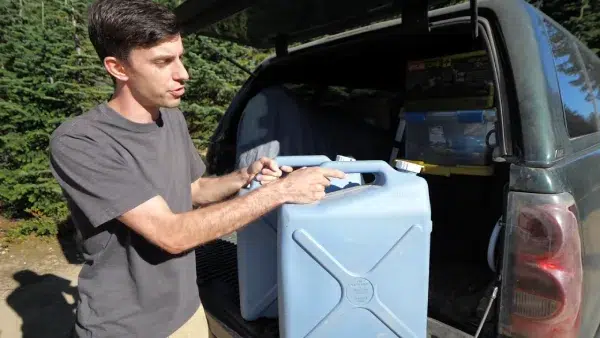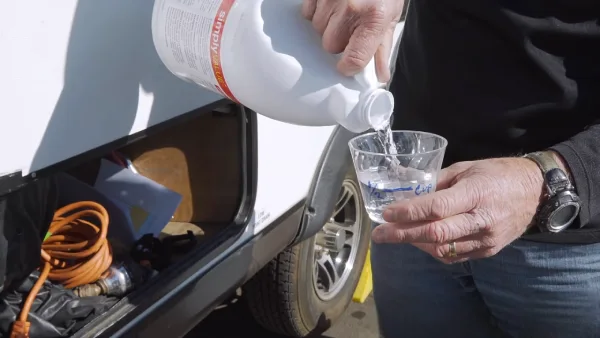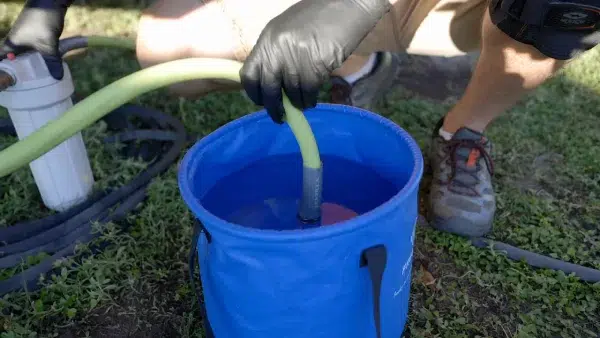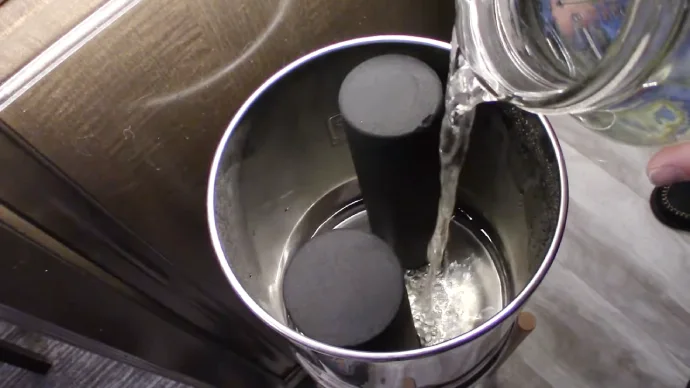Last Updated on June 20, 2023
Having fresh water on board your RV is essential for a comfortable and enjoyable trip. But have you ever wondered how long you should keep that water in your tank before replacing it? It’s an important question, as drinking stale or contaminated water can have unpleasant consequences.
The answer depends on several factors, including temperature, humidity, exposure to sunlight, and type of water source. In general, fresh water in an RV tank should be replaced every two weeks. And if your RV is parked in a hot, humid climate, you should replace it even more often.
Throughout this article, we’ll discuss the above factors that affect the lifespan of fresh water in an RV tank and provide some tips for ensuring that your water stays clean and safe during your travels. So, let’s dive in.
How Long To Keep Fresh Water in RV Tank: Factors That Affect

The quality of water in your RV tank can be affected by several factors. Here are the most common ones:
01. Temperature
The top factor to consider when keeping fresh water in your RV tank is the temperature. Hotter temperatures speed up the growth of bacteria and can cause harmful organisms to multiply quickly.
This is why it’s essential to keep your RV in a cool, shaded area whenever possible and to ensure you don’t leave the fresh water in your tank for more than two weeks. And more importantly, do not allow hot water to enter your tank.
Plus, if you are traveling in the summer, drinking water from a cooler or accessing a convenience store for bottled water is recommended. You can also fill your tank with pre-treated water from a reputable source.
02. Humidity
Water quality in your RV tank is greatly affected by humidity. High humidity levels can lead to the growth of mold and mildew, which can contaminate your water supply. When moisture builds up inside your RV, it creates an ideal environment for bacteria and other microorganisms to thrive.
A dehumidifier is one way to prevent excess humidity in your RV. This device helps remove excess moisture from the air, reducing the risk of mold growth and improving air quality. You can also improve ventilation inside your RV by opening windows and doors or installing a fan.
Another way to reduce humidity levels is by storing your RV in a dry location when not in use. If you live in an area with high humidity levels, consider investing in a climate-controlled storage unit for your RV.
Monitoring humidity levels regularly and taking action if necessary, to prevent water contamination in your RV tank is essential. By keeping humidity levels low, you can ensure that your fresh water supply remains safe and clean for your and your family’s consumption.
03. Exposure to Sunlight
Your RV tank’s water quality can be significantly affected by sunlight exposure. When water is exposed to sunlight, it can lead to the growth of algae and bacteria, which can cause health risks if consumed.
To prevent this from happening, it’s essential to keep your RV tank out of direct sunlight as much as possible. If you’re camping in an area with limited shade, consider covering your RV tank with a tarp or other protective cover. This will help to reduce the amount of sunlight that reaches the water.
It’s also important to note that high temperatures can exacerbate the effects of exposure to sunlight. Water can accelerate bacteria and algae growth when heated, making it even more critical to keep your RV tank shaded and cool.
In addition to preventing exposure to sunlight, regular cleaning and sanitization are crucial for maintaining fresh water in your RV tank. By keeping your tank clean and free from debris, you can help prevent the growth of harmful bacteria and ensure that your water remains safe for consumption.
04. Type of Water Source
The type of water source used to fill your RV tank can significantly impact the quality and lifespan of your freshwater supply. Considering your water source before filling up your RV tank is crucial.
If you are filling up from a municipal water source, the water is likely treated with chemicals such as chlorine or fluoride. While these chemicals may help make the water safe for consumption, they can also affect the taste and smell of the water.
Also, some municipal water sources may contain minerals or contaminants that could lead to build-up in your RV’s plumbing system.
On the other hand, if you are using well water or natural springs as your source of freshwater, you may need to take extra precautions to ensure the water is safe for consumption. These sources may contain bacteria or other harmful microorganisms that could cause illness if not properly treated.
How do you know when to change your RV’s fresh water?

One of the most important things to remember is that fresh water can become contaminated over time, especially if it’s not properly maintained. Here are some ways to determine whether or not it’s time for a fresh fill-up:
Visual Inspection
Check for any discoloration or cloudiness in the water, as this could indicate the presence of bacteria or other contaminants. Look for any debris or sediment at the bottom of the tank. This can be a breeding ground for harmful microorganisms and should be cleaned out regularly.
It’s also important to pay attention to the water age in your RV tank. Even if it looks clear and clean, water that has been sitting for an extended period of time can still pose health risks due to the development of bacteria and mold.
As a general rule, it’s recommended that you change out your RV tank water every 2 to 3 weeks.
Regular cleaning and sanitization can help prevent these issues from occurring. Consider using a water filter to remove impurities before entering your RV tank. This will enhance the taste and quality of drinking water and reduce the risk of contamination.
Smell Test
To conduct a smell test, turn on your RV’s water pump and run the water for a few minutes. Take note of any unusual smells that come from the faucet or showerhead. If you detect an odor similar to rotten eggs or sulfur, it could indicate the presence of hydrogen sulfide gas, which can be harmful if ingested.
It’s important to note that not all odors are harmful, but they can still make your drinking water unappealing. In some cases, you may be able to eliminate minor odors by flushing out your RV’s water system with fresh water or adding a small amount of bleach to disinfect the tank.
To prevent unpleasant odors from developing in the first place, it’s essential to maintain proper hygiene and sanitation practices. This includes regularly cleaning your RV’s fresh water tank and filtering your water to remove impurities and contaminants.
Taste Test
The taste of the water can be affected by several factors, including the type of water source, exposure to sunlight, and temperature.
It is important to note that even if the water tastes fine, it may still contain harmful bacteria or other contaminants. Regular cleaning and sanitization of your RV tank are crucial for maintaining fresh and safe drinking water.
And regular maintenance and using a high-quality water filter can also help improve the taste and quality of your RV’s fresh water supply. A filter can remove impurities such as sediment, chlorine, and bacteria.
What are the risks of keeping old water in your RV tank?
RV tanks with old water can pose several risks to your health. Over time, bacteria and mold can develop in the stagnant water, which can cause illness if consumed. The longer the water is kept in the tank, the higher the risk of contamination.
Bacteria thrive in warm and moist environments, making an RV tank a perfect breeding ground. Leaving old water in your RV for an extended period can lead to the growth of harmful bacteria such as Legionella pneumophila, which causes Legionnaires’ disease. This disease is a severe form of pneumonia that can be fatal if left untreated.
Besides bacteria, mold can grow in old water sitting in an RV tank for too long. Mold spores are everywhere and can quickly spread throughout your RV’s plumbing system. Inhaling mold spores can cause respiratory problems such as allergies, asthma attacks, or infections.
Monitoring and maintaining fresh water in your RV tank regularly is crucial to avoid these health risks. You should change the water frequently and sanitize the tank periodically to prevent bacterial growth.
Should I drain my RV water tank after each use?

While it is not necessary to drain your RV water tank after each use, it is still recommended. This is because stale water left in the tank for an extended period can cause contaminants to grow in the tank, giving rise to foul odors and bacteria.
By draining the tank and flushing it with fresh water after each use, you can help prevent this issue. Another reason to drain your RV water tank is if you plan on storing your RV for an extended period of time.
When stored, water can stagnate in the tank and cause damage to the internal components, such as the pump or the water heater. Therefore, before storing your RV, it is advisable to empty the water tank completely and refill it with fresh water when you are ready to use it again.
Prioritize the Safety of Your Adventure with Fresh Water in Your RV Tank
The question of how long to keep fresh water in an RV tank is crucial for every RV owner.
Temperature, humidity, sun exposure, and type of water source are all factors that affect the quality of the water in your RV tank. Regular cleaning, water filter use and sanitization are practical tips that help maintain fresh water in your RV tank.
Being mindful of the risks associated with storing old water in your RV is essential. These risks include the development of bacteria and mold, which pose significant health risks to you and your family. Visual inspection, smell test, and taste test are simple ways to determine when to change the water in your RV tank.
Therefore, monitoring and maintaining a freshwater supply in your RV tank should be a top priority. Doing so ensures you have clean and safe drinking water while on the road. You don’t want to cut short your travel plans due to a contaminated or stale water supply. It’s better to err on caution than to compromise on safety.



